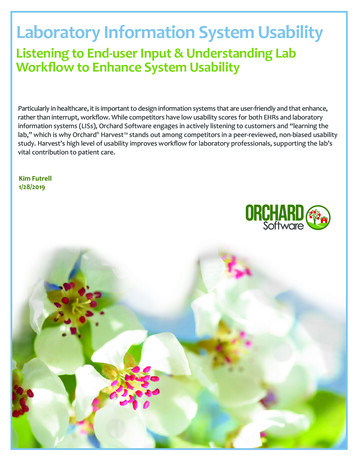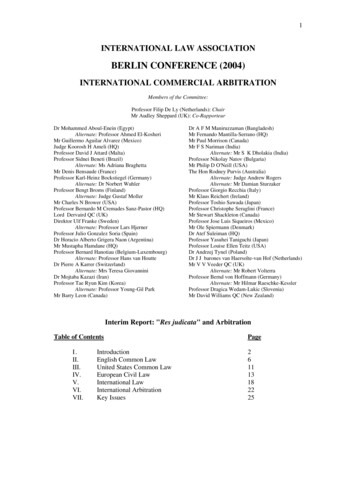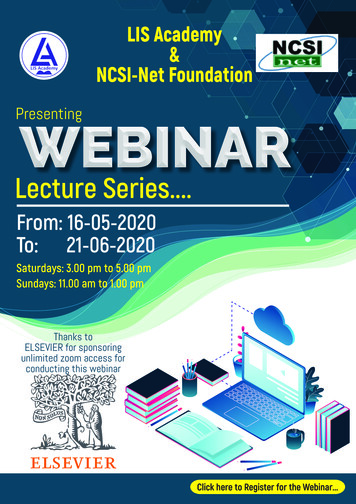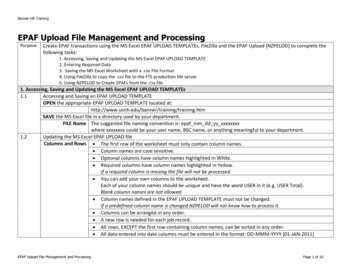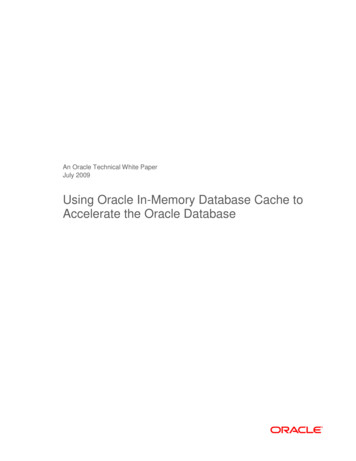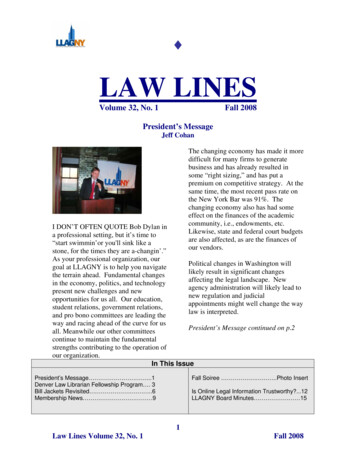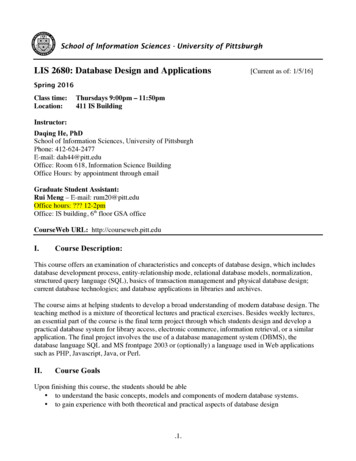
Transcription
School of Information Sciences - University of PittsburghLIS 2680: Database Design and Applications[Current as of: 1/5/16]Spring 2016Class time:Location:Thursdays 9:00pm – 11:50pm411 IS BuildingInstructor:Daqing He, PhDSchool of Information Sciences, University of PittsburghPhone: 412-624-2477E-mail: dah44@pitt.eduOffice: Room 618, Information Science BuildingOffice Hours: by appointment through emailGraduate Student Assistant:Rui Meng – E-mail: rum20@pitt.eduOffice hours: ? 12-2pmOffice: IS building, 6th floor GSA officeCourseWeb URL: http://courseweb.pitt.eduI.Course Description:This course offers an examination of characteristics and concepts of database design, which includesdatabase development process, entity-relationship mode, relational database models, normalization,structured query language (SQL), basics of transaction management and physical database design;current database technologies; and database applications in libraries and archives.The course aims at helping students to develop a broad understanding of modern database design. Theteaching method is a mixture of theoretical lectures and practical exercises. Besides weekly lectures,an essential part of the course is the final term project through which students design and develop apractical database system for library access, electronic commerce, information retrieval, or a similarapplication. The final project involves the use of a database management system (DBMS), thedatabase language SQL and MS frontpage 2003 or (optionally) a language used in Web applicationssuch as PHP, Javascript, Java, or Perl.II.Course GoalsUpon finishing this course, the students should be able to understand the basic concepts, models and components of modern database systems. to gain experience with both theoretical and practical aspects of database design.1.
III.to be able to design and develop a simple database project using existing database managementsystems.to understand the current state and likely future directions of database applications in libraryscience and information science in general.CourseWeb Information:CourseWeb is a Web-based system using BlackBoard software that facilitates course-relatedcommunication as well as distribution of course materials and grades. You can access CourseWeb athttp://courseweb.pitt.edu . You must log in with your University Computer Account – this is the onethat goes with your ‘pitt.edu’ e-mail address. If you do not have a Pitt account, please contactComputing Services (CSSD) at 412-624-HELP [4357] to find out how to get one. Course-related email will be sent to your Pitt e-mail account. If you do not read e-mail on your Pitt account, you areresponsible for forwarding any e-mail received on your Pitt account to the e-mail address that you use.See http://accounts.pitt.edu/ for information on managing your Pitt account and forwarding e-mail. Ifyou have trouble logging in to CourseWeb, you may need to log in to the accounts website above toactivate your Pitt e-mail account. Call 412-624-HELP with any problems relating to your account.IV.Required textbooks and ReadingsPeter Rob, Carlos Coronel. Database Systems: Design, Implementation, & Management. Anyedition between 2004 and 2014, Thomson Course Technology, 2010.1 Hernandez, Michael J. Database design for mere mortals: a hands-on guide to relational databasedesign. Pearson Education, 2013.Complementary materials will be distributed during the class when appropriate. V.Course Schedule SummaryWeekDateTheme1January 7IntroductionData Models,2January 143January 21Relational DBER ModelTopicsIntroduction to database and DBMSIntroduction to the courseLab 1: Software preparationData ModelsRelational DatabaseLab 2: Access, MySQL, DBTools,PostgreSQLQuiz 1Entities and RelationsER Diagram1There are plenty of used versions of this book available online or at the university book store. You can get much cheaperone (usually about 10 to 20) to buy online rather than buying a new one.2.
Lab 3: Visio TutorialNormalization4January 28DB Design5February 46February 11SQL7February 18SQL 2SQL 38February 25Midterm Exam9March 10March 17March 24XMLInternet DatabaseEnvironment11Assignment 2Quiz 2Design ProcedureConceptual DesignLab 5: DB DesignSQLLab 6: SQLProject DeadlineSQL 2Lab 7: SQL 2Quiz 3SQL 3Lab 8: SQL 3Assignment 3Exam in the first 90 minutesMarch 3Team Talks10Assignment 1Normalization and Normal formsNormalization and DB DesignLab 4: NormalizationProject Proposal TalksSpring Break University closedNo classXML QueryLab 9:Quiz 4Object-Oriented Modeling, Distributed DBand NoSQLMarch 31Lab 10: CouchDB12April 713April 14DatabaseManagementAssignment 4Database Transaction Management,Lab 11:DatabaseApplications in.3.
14April 2115April 28VI.LibrariesData Mining andData WarehouseLab 12:Quiz 5Data MiningData WarehouseLab 13:Student TeampresentationsAssessmentParticipation 10%Class attendance is required for success in this course, as material covered in class may not beincluded in the readings. Participation is based on the following two activities:1. off-class contribution to each week’s “my comments” after the class (5 participation points).Your comments should be posted in the discussion board of the courseweb. Total 10 responseswill be needed for earning the 5 participation points, each of which counts .5 participationpoint.2. in class 10-minute quiz. Throughout the semester, we will have total five quizs. Each will lastfor about 10 minutes at the beginning of the class. Each quiz lasts for about 10 minutes, and afull mark in each quiz will contribute to the 1 participation point in the final grade.If you must miss a class, please notify the teaching assistant, and make arrangements to obtain coursenotes and handouts. Makeup exams and quiz will not be offered except under extreme circumstances.Assignment 32%There are total four assignments, each of which will count 8% in the final course score. The deadlineof submitting each assignment is before 9am of the due date. Each 24 hours delay will have 40%deduction of the maximal score. No submission later than 2 days will be accepted except in the case ofemergencies and personal disasters.Exams 28%The exam will last 90 minutes, and covers all the topics taught in the weeks before it. Common examquestions include multiple choices, short definitions, and discussion questions.Previous year’s exam questions and answers can be located at the past exam section in the Courseweb.Term Project 30%Please see section VIII for detail description of term project.4.
Course Grading Scale:The final grade depends on the percentage of points you have earned, and the definition of lettergrades is: 90 A- 93, 93 A 97, 97 A 100 80 B- 83, 83 B 87, 87 B 90 70 C- 73, 73 C 77, 77 C 80 60 D 70, F 60VII. Detailed Course ScheduleWeek 1 IntroductionObjectives: After this class, you should be able to– tell the difference between data and information– understand what is database, database management– articulate the reasons for having database systems– tell the history of modern databases– understand what you will learn from this course– tell what you expected to achieve in this courseRequired Readings Rob&Coronel, Chapter 1Week 2 Data Models and Relational DatabasesObjectives: After this class, you should be able to– tell and understand the different degrees of data abstraction– tell the idea behind hierarchical and network models– understand the logical view of data in relational model– understand the characteristics of relational operators– able to calculate the outcomes of relational operatorsRequired Readings: Rob&Coronel, Chapters 2 and 3Week 3 Entity-Relation ModelingObjectives: After this class, you should be able to.5.
––tell how to define and refine relationships in database designunderstand how to develop a ER diagram for database designRequired Readings: Rob&Coronel, Chapter 4.Week 4 NormalizationObjectives: After this class, you should be able to– understanding what normalization is and its role in database design– tell 1NF, 2NF, 3NF, BCNF, and 4NF– able to transform tables from lower normal forms to higher normal forms– understand that normalization and ER modeling are used concurrently to produce a gooddatabase designRequired Readings: Rob&Coronel, Chapter 5Week 5 DB DesignObjectives: After this class, you should be able to– understand that a successful database design must reflect the information system of which thedatabase is a part– understand Systems Development Life Cycle (SDLC) and Database Life Cycle (DBLC)– know how to conduct evaluation and revision within the SDLC and DBLC frameworks– tell the pros and cons of database design strategies: top-down vs. bottom-up design, andcentralized vs. decentralized designRequired Readings: Rob&Coronel, Chapter 8Week 6 SQL 1Objectives: After this class, you should be able to– understanding the basic commands and functions of SQL– able to use SQL for data administration (e.g. create tables, indexes).6.
–able to use SQL for data manipulation (e.g., add, modify, delete data)Required Readings: Rob&Coronel, Chapter 6Week 7 SQL-IIObjectives: After this class, you should be able to– understanding the basic commands and functions of SQL– able to use SQL for data administration (e.g. create tables, indexes)– able to use SQL for data manipulation (e.g., add, modify, delete data)Required Readings: Rob&Coronel, Chapter 7Week 8 SQL IIIObjectives: After this class, you should be able to– understand the advanced commands and functions of SQL– able to use SQL join operator and relational set operators– able to use SQL subqueries and correlated queries– able to use SQL for data administration (e.g. create tables, indexes)Required Readings:Coronel, Chapter 7&8Week 11 XML for DatabaseObjectives: After this class, you should be able to– Describe basic concepts of XML– explain why XML is important to Web database developmentRequired Readings:Coronel, Chapters 14.7.
Week 12 Internet Database EnvironmentObjectives: After this class, you should be able to– explain client/server architectures– understand the internet and database connection– list common internet architecture componentsRequired Readings:Coronel, Chapters 14Week 13 DB and LibraryObjectives: After this class, you should be able to– define e-commerce and identify e-commerce companies– describe the styles and architecture of e-commerce– explain the issues related to e-commerce– explain why and how the client server architecture is extended– identify and explain simple ColdFusion codeRequired Readings: Rob&Coronel, Chapters 13 and 14Week 14 Data Warehouse and Data MiningObjectives: After this class, you should be able to– explain the difference between operational data and decision support data– explain the concepts of data warehouse, online analytical processing, and why they are needed– explain star schemas as the extension to RDBMS for ROLAP– define data mining and identify patterns and issues in itRequired Readings: Rob&Coronel, Chapter 12VIII. Term ProjectsIntroduction:.8.
The term project is designed for students to integrate and extend knowledge acquired throughout thecourse and to apply that knowledge to solve a problem of substantial scope. The task is to propose,plan and develop a prototype database system to handle a real problem that matters to real people,although there could be some degree of simplification to down scale the effort to solve the problem.Requirements to the ReportThe final outcome of your term project should include two major components:1. Database design. A report (about 2000 words) which includes:a. Problem statementb. Database overview and scopec. Conceptual schemad. Data dictionarye. Sample SQL queries2. Database Implementation. You are free to use whatever techniques and database managementsystems to implement the database. The minimal requirements are that the databaseimplementation should have functions such as data entry, update, querying, and simple report.Milestones for the project:Introduction of term project:Project topic deadline:Project proposal presentation:Final project report and demo:week 2week 5week 9week 15When writing either your assignment essays or project reports, please follow one of the establishedstyles for reference and citation (visit “Research, Writing, and Style s.html) for various existing styles). However, you arehighly recommended to adopt the American Psychological Association APA style (the fifth edition ofthe Publication Manual of the American Psychological Assocation published by the AmericanPsychological Association (2001)). “A Guide for Writing Research Papers”(http://webster.commnet.edu/apa/) is a wonderful online place to obtain the guidance for this style.IX.Course PoliciesGround rules for class discussionOn-class interaction and discussion will be an important means of learning in this course, therefore, itis important that we work together to create a constructive environment by observing these rules: You should participate in the discussion of ideas. You should respect diverse points of view. You should aware the diverse backgrounds of peers. You may not belittle or personally criticize another individual for holding a point of viewdifferent than your own Your use of language should be respectful of other individuals or groups.9.
PlagiarismIt is expected that the work you submit in this course will be your own. While collaboration isallowed for the course project, it should be approved in advance and the nature of each contributionshould be specified in the project proposal and the final submission.The following statement is taken from The Teaching Assistant Experience: A Handbook for TeachingAssistants and Teaching Fellows at the University of Pittsburgh (A.P. Haley and J.M. Nicoll, eds.) ]Plagiarism means submitting work as your own that is someone else’s. For example, copyingmaterial from a book or other source without acknowledging that the works or ideas aresomeone else’s and not your own is plagiarism. If you copy an author’s words exactly, treat thepassage as a direct quotation and supply the appropriate citation. If you use someone else’sideas, even if you paraphrase the wording, appropriate credit should be given. You havecommitted plagiarism if you purchase a term paper or submit a paper as your own that you didnot write2.Plagiarism is a violation of the University of Pittsburgh’s standards on academic honesty, andviolations of this policy are taken seriously. From the Guidelines on Academic Integrity:Student and Faculty Obligations and Hearing Procedures (effective September, 1995):A student has an obligation to exhibit honesty, and to respect the ethical standards of the historicalprofession in carrying out his or her academic assignments. Without limiting the application of thisprinciple, a student may be found to have violated this obligation if he or she: Presents as one’s own, for academic evaluation, the ideas, representations, or words of anotherperson or persons without customary and proper acknowledgment of sources. Submits the work of another person in a manner which represents the work to be one’s own.[Quotation ellipsed.] 3Special NeedsStudents with disabilities who require special accommodations or other classroom modificationsshould notify the instructor and the University's Office of Disability Resources & Services (DRS) nolater than the 2nd week of the term. Students may be asked to provide documentation of theirdisability to determine the appropriateness of the request. DRS is located in 216 William Pitt Unionand can be contacted at 648-7890 (Voice), 624-3346(Fax), and 383-7355(TTY). Students who mustmiss an exam or class due to religious observances must notify the instructor ahead of time and makealternative arrangements.2B. G. Davis, Tools for Teaching (San Francisco: Jossey-Bass, 1993), 300.3University of Pittsburgh, Guidelines on Academic Integrity: Student and Faculty Obligations andHearing Procedures (Pittsburgh: University of Pittsburgh, 1995), 7-8.10.
Hernandez, Michael J. Database design for mere mortals: a hands-on guide to relational database design. Pearson Education, 2013. Complementary materials will be distributed during the class when appropriate. V. Course Schedule Summary Week Date Theme Topics 1 January 7 Introduction Introduction to database and DBMS Introduction to the course
